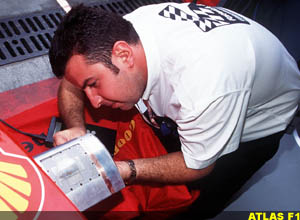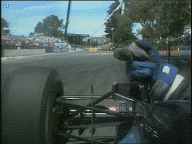|
 One of the things that has revolutionized the television coverage of Grand Prix racing over the last ten years is without doubt the on-board camera. Mounted at various points around several of the cars in any Grand Prix race, it reveals the driverís eye view of what is going on in his own car, and those ahead or behind him at various times during the race. One of the things that has revolutionized the television coverage of Grand Prix racing over the last ten years is without doubt the on-board camera. Mounted at various points around several of the cars in any Grand Prix race, it reveals the driverís eye view of what is going on in his own car, and those ahead or behind him at various times during the race.
In some ways, it allows the viewers to spy on a car. In many instances, the driver is clearly unaware of it. It reveals his uninhibited moods, his gestures, the slightest action that can hint at a technological difference. It carries pictures of accidents and near misses, the closeness and spectacular nature of Grand Prix racing. It is yet another tool in the popularizing of the sport.
The on-board camera was first developed for Australian touring car racing in the mid-1980s and it has extended to revolving cameras in the cockpit where drivers are even interviewed mid-race. Single seaters do not have that space in which to do that, however.
The technology came to Britain in the late eighties where the Formula One Constructors Associationís(FOCA) television arm has continued to develop it to the extent that it is now in its fifth version. The system has blossomed throughout the years, so that cameras sprout from every part of a Grand Prix car. Terrestrial channels receive three different angles from nine different cars per race but FOCA successor Formula One Administrationís (FOA) digital TV signal, where there is a dedicated on-board channel, receives pictures from many more.
 The actual hardware involved is obviously kept to a minimum. Not only does it add weight where a teamís engineer is desperately trying to lose it, but it can also increase drag to the carefully studied aerodynamics of a Formula One racing car. The lens itself is housed in an aerodynamic pod. Each car carries either a camera or a dummy of the same weight and shape, produced by the team, on the roll hoop. They also carry a camera or dummy in one of the following positions: on the front wing endplate, the nose, the side of the chassis and looking at the driver. Thus, each car carries either cameras or dummies in two positions, so that every car has the same drag and weight penalty. Each lens is covered by a transparent polythene film which can we wound on when it gets dirty. The transmission equipment is housed elsewhere in the car and the whole pack is maintained by a permanent staff devoted to that task. The actual hardware involved is obviously kept to a minimum. Not only does it add weight where a teamís engineer is desperately trying to lose it, but it can also increase drag to the carefully studied aerodynamics of a Formula One racing car. The lens itself is housed in an aerodynamic pod. Each car carries either a camera or a dummy of the same weight and shape, produced by the team, on the roll hoop. They also carry a camera or dummy in one of the following positions: on the front wing endplate, the nose, the side of the chassis and looking at the driver. Thus, each car carries either cameras or dummies in two positions, so that every car has the same drag and weight penalty. Each lens is covered by a transparent polythene film which can we wound on when it gets dirty. The transmission equipment is housed elsewhere in the car and the whole pack is maintained by a permanent staff devoted to that task.
The signal that emanates from the car is then bounced off a helicopter back to FOAís own TV studio on the ground. However, tests are under way with various other methods of receiving the transmitted signal, in order to cut out the helicopter which is not only expensive but cannot always fly in inclement weather and promotes interference when the signal is interrupted by bridges, trees and sometimes buildings. Inside the TV studio, the signal is distributed to the host broadcaster where applicable, but also to FOAís own on-board dedicated digital TV channel, exclusively available to subscribers in some parts of the world.
The on-board pictures are fascinating in many ways. They show the driverís own ability in all kinds of situations, the stresses and strains that he is subjected to, the amount that he can see, particularly in terms of spray on a wet track. They can show the speed of his reactions when the car gets out of shape. They have provided fascinating footage of controversial incidents, such as that in Adelaide when Michael Schumacher ran wide and then collided with Damon Hill, ruining the latterís World Championship chances. Or the incident last year when Villeneuve dived down the inside of Schumacher at Jerez and the the latter rammed into his contender, this time to the German driverís detriment. Both times, the on-board film was carefully scrutinized by the stewards and gave the viewers live footage of what really happened.
 But then there are the things that a driver does to the car, the gestures that he makes to other drivers that are also of interest. In truth, if a driver thought of the presence of the TV lens beforehand, then he might not have made them - A shaken fist, a rude gesture or even a wave such as that given by David Coulthard to Mika Hakkinen as he overtook him during the recent Italian Grand Prix. And what the drivers do within the car - buttons they push, the steering wheel they use - are also of great interest to other teams. But then there are the things that a driver does to the car, the gestures that he makes to other drivers that are also of interest. In truth, if a driver thought of the presence of the TV lens beforehand, then he might not have made them - A shaken fist, a rude gesture or even a wave such as that given by David Coulthard to Mika Hakkinen as he overtook him during the recent Italian Grand Prix. And what the drivers do within the car - buttons they push, the steering wheel they use - are also of great interest to other teams.
Ferrari, for example, has been accused more than once by its contender Mclaren of spying on the leading constructor's technology. Ferrariís technical director, Ross Brawn, admits as much: "Itís quite interesting to look at footage of other teams' on-board cameras, and Iím sure every other team has a look at on-board footage to see how other drivers are driving the car. You can see when a driver has good control over the car. If you looked at McLaren at the beginning of the season, the guys looked as though they were on a Sunday afternoon drive. If you look at McLaren now, they look as though theyíre having to push a bit harder. So those sort of things become apparent. There are a number of functions that other drivers carry out which we try to understand."
Brawn also refers to the famous mystery of the McLaren Green Button, saying: "We donít understand them all because we donít have access to all the information but with McLaren, for instance, you can quite clearly see them pressing certain buttons before they enter certain corners and they repeat that every lap, so thereís obviously some function of the chassis, engine or gearbox that they are changing. Those things are quite interesting. You can also use the on-board footage in the race as well to try and judge traffic, when you see a driver coming up to slower cars. Itís not completely reliable in the sense that they donít always show your driver, but often there will be long spells with your driver and it can help to see what the traffic situation is. That too is very useful."
|

